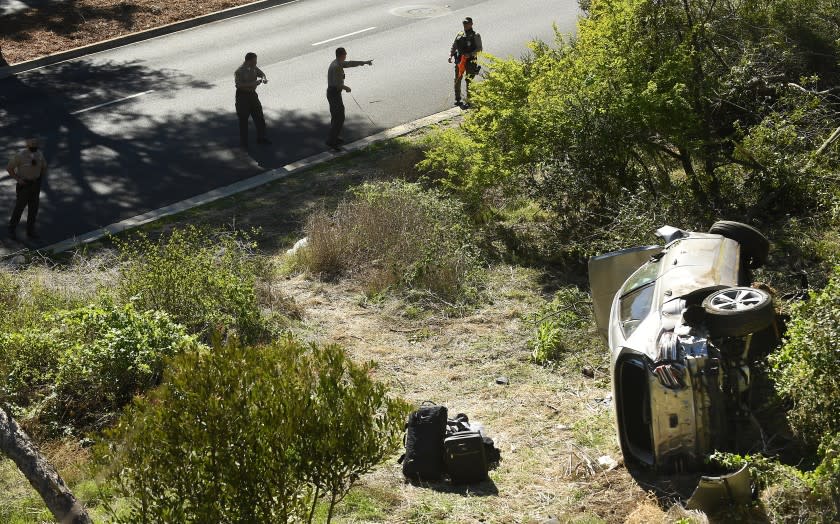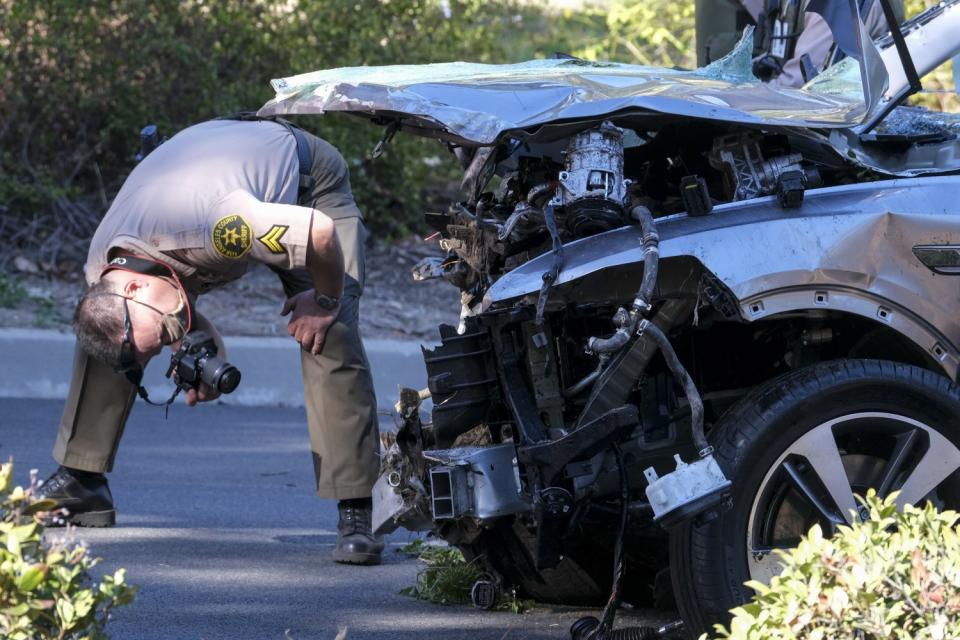Bone breaking skin and possible infection are big issues in Tiger Woods' comeback

More will be revealed on the condition of Tiger Woods in the coming days and weeks, including his quality of life moving forward, let alone the lesser question of whether he might at some point be able to resume his golf career in the wake of a catastrophic rollover car accident.
Posted on Woods’ Twitter account early Wednesday was the following statement from Dr. Anish Mahajan, chief medical officer and interim chief executive of Harbor-UCLA Medical Center, describing his condition:
“Mr. Woods suffered significant orthopaedic injuries to his right lower extremity that were treated during emergency surgery by orthopaedic trauma specialists at Harbor-UCLA Medical Center, a level-1 trauma center. Comminuted open fractures affecting both the upper and lower portions of the tibia and fibula bones were stabilized by inserting a rod into the tibia.
“Additional injuries to the bones of the foot and ankle were stabilized with a combination of screws and pins. Trauma to the muscle and soft-tissue of the leg required surgical release of the covering of the muscles to relieve pressure due to swelling.”
Dr. Kenneth Jung, an orthopedic foot and ankle surgeon, provided further explanation of that summary. Although Jung is not involved in the treatment of Woods, he spoke in general terms about the type of injuries described, which commonly occur in high-energy car crashes.
That the injuries occurred to the lower-right leg of Woods is not surprising, Jung said, because those typically happen when a driver is slamming on the brake, as opposed to the left leg, which might be off to the side. The demolished front end of the SUV that Woods was driving appeared to be compressed and caved in by the accident.
The tibia and fibula are the two bones in your lower leg, and a comminuted fracture refers to a bone being broken into multiple fragments, as opposed to a clean break.
The term “open” means the bone broke through the skin and was exposed to the outside world. That greatly increases the risk of infection, as occurred with Washington Football Team quarterback Alex Smith, who suffered a gruesome leg break that, after subsequent infections, brought the risk of amputation and was life-threatening.
“A lot of people focus on bone injuries, but that’s only part of the tale,” said Jung of the Kerlan-Jobe Institute in Los Angeles. “The soft tissue envelope, or the skin, is actually very important as well. If you don’t have skin covering the bone, it really doesn’t matter how the bone looks or heals.”
With Woods, or anyone who suffers an open fracture, these first few days after an accident are critical in charting the path forward.
“It’s usually pretty routine in the first 24 to 48 hours to bring someone back to the operating room to wash out the tissue, wash out the wounds again, reinspect the tissue to see if there’s any necrosis or tissue death,” Jung said.
The tibia is the shin bone you can feel under your skin. If wounds there have trouble healing, doctors might use skin grafts or transfer muscles from other parts of the body for coverage of that bone.
In his statement on Woods, Mahajan described trauma to the muscle and soft tissue of the leg that required “surgical release” of the fascia covering the muscles. That surgery is performed to release pressure that results from swelling after trauma.
“I tell patients that your muscles are basically in these compartments, almost like sausages,” Jung said. “Imagine boiling a sausage and the meat starts expanding. When you make a slit in the casing of the sausage, the meat balloons out. That’s similar to what they’re doing with those compartment releases.”

Jung said compartment syndrome can happen almost immediately and results in uncontrollable pain.
A combination of screws and pins were used to stabilize the bones of Woods’ foot and ankle. Whereas screws typically are used to affix fractured bones, pins are often used to stabilize joints which might have been dislocated.
Jung said a common concern is an injury to the Lisfranc joint complex in the middle of the foot, again common in car accidents when a driver is pushing on the brake pedal at the time of impact.
“Those injuries have a high association with post-traumatic arthritis,” he said. “That would raise concern in my mind not just with golf but going forward in life. That would manifest as pain and stiffness in the joints of the foot.”
Jung said even for doctors working on Woods, it’s far too premature to predict an outcome. At the moment, so much depends on the skin and avoidance of infection.
“He can have the most perfectly aligned bones, certain orthopedic surgeons, they've done the greatest work in the world to make everything aligned,” he said. “But if he unfortunately would develop an infection, that all would get put into jeopardy.”
The road to recovery is likely long. The first few days after this type of injury typically require antibiotic treatment and monitoring for infection and blood flow, according to Dr. Gregory Tennant, an orthopedic surgeon at Kaiser Permanente Medical Center in Fontana.
In the six to nine months that follow, the focus likely will be on bone and wound healing, followed by a recovery phase of physical therapy and rehab.
“My expectation would be that I wouldn’t anticipate him up and walking around for a while,” Tennant said.
Although the majority of the injuries described by Woods’ doctors are in his lower extremities, the golfer recently had undergone his fifth back surgery. It’s possible the accident would affect his recovery from that.
“Trauma is never truly an isolated event,” Tennant said. “It is not uncommon to identify injuries — even significant injuries — days later, as the initial high-energy injuries are dealt with.”
Ultimately, though, Tennant said Woods is in excellent hands at Harbor-UCLA, which handles these kinds of injuries all the time, and is optimistic about the legendary golfer's recovery.
“Tiger Woods has been a winner his whole life,” he said, “and one thing I’ve learned is that you don’t bet against winners. You don’t bet against Michael Jordan. You don’t bet against Tiger Woods.”
This story originally appeared in Los Angeles Times.

 Yahoo Movies
Yahoo Movies 
